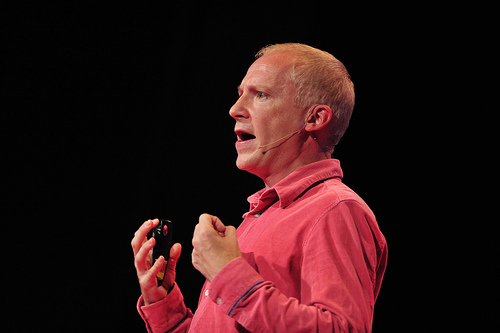
Mathematician and science communicator Marcus du Sautoy began his talk with the story of Evariste Galois, a Paris revolutionary who died in his brother’s arms. The night before, Galois had stayed up all night trying to explain his mathematical ideas before his duel the next day. He was trying to explain symmetry.
Symmetry helps us understand the world: crystals, microbiology. Swine flu virus is a symmetrical object, and uses symmetry to its advantage as it attacks. Symmetry communicates genetic information. We perceive symmetry in human faces as beautiful. Symmetry is helping in uncovering the nature of fundamental particles. Scientists and artists both are interested in symmetry, although artists’ relationship with it may be more “ambiguous,” quips Sautoy. Artists set up expectations of symmetry, and then break them. 14th-century Japanese essays say “Uniformity is undesireable.”
But … what is symmetry? Galois asked whether by knowing one symmetry, we know all of them. One characteristic of symmetry is that by fixing an object at a point and rotating it in some way, that rotation can happen without it seeming that the object has rotated.
A “twisted, six-pointed starfish,” for example, can be rotated by thirds or fifths of a turn, and still look the same. But after the rotations you can do something besides rotation. You can “pick it up and put it down again.” Galois called this the “zero” symmetry. A triangle has the same property. It can be rotated — and also “reflected.”
Math is not a spectator sport, says du Sautoy. You have to actually do it to understand it, to enjoy it.
The interaction of the symmetries is different from the symmetry itself. In other words: “Are the symmetries themselves symmetrical?” He uses a grid of rows and columns representing the points of a symmetrical figure to illustrate whether it matters what order of rotations you can perform on a given figure. This allows us to explore how the symmetries between different objects are fundamentally different. This allows us to determine whether two different symmetrical objects have the same underlying abstract symmetry.
For example, there are only two objects with six symmetries: the twisted six-pointed starfish and the equilateral triangle from the original example.
But Galois’ language for symmetry allows us to understand the symmetry of objects that we cannot actually see. Du Sautoy works on symmetrical objects in high-dimensional spaces.
Du Sautoy presented TED with a new symmetrical object he was working on the previous night, and offered any TEDster a chance to have their name as the name of the symmetrical object. To win, they had to say how many digits are in the number of symmetries a Rubik’s cube has. Speaker Andrea Ghez won the contest.
Photo: Marcus du Sautoy at TEDGlobal 2009, Session 6: “Curious and curiouser,” July 22, 2009, in Oxford, UK. Credit: TED / James Duncan Davidson
Comments